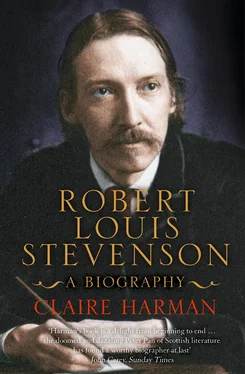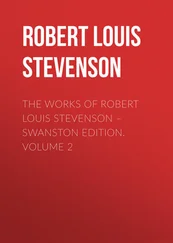I am entering on a profession which must engross the strength of my powers and to which I shall try to devote my energies. What I should prefer would be to search dying people in lowly places of the town and help them; but I cannot trust myself in such places. I told you my weak point before and you will understand me. 34
The pious young man was imagining himself as some sort of Jesus of the streets – and yet, he was too unworthy for that. Sunday school teaching was perhaps the only option open to him, he mused – but no, that also required a purer spirit.
The dark talk of not being trustworthy in ‘lowly places of the town’ refers (not without a tinge of pride) to Louis’s rapid escalation of worldly knowledge during his student years. He later said that his childhood piety had gone hand in hand with its correlate, ‘precocious depravity’, 35 which ranged from trying to summon up the Devil to solemn, secret experiments in blasphemy. Writing about his childhood at the age of twenty-two, Stevenson was in no mood to dismiss these traits, but saw them as consistent with his adult behaviour: ‘I find that same morbid bias, [ … ] the same small cowardice and small vanity, ever ready to lead me into petty falsehood.’ 36 He saw ‘a parallel case’ between his own early years and those of the Covenanter Walter Pringle of Greenknow, whose memoirs had been one of Cummy’s permitted texts. This is an extraordinary thing to say. Pringle’s Memoirs are stuffed with the harshest language: he describes his youth as ‘years of darkness, deadness, and sinfulness’ when he committed ‘abominations’ and ‘slept about the brink of the bottomless pit’, 37 all in the context of later conversion, in other words, all in a priggish context. Stevenson could certainly be priggish too: the Covenanting childhood left deep divisions in his mind between good and evil, heaven and the pit, and ‘something of the Shorter Catechist’ hung about him, as W.E. Henley was to observe, even in his most apparently easy-going, atheistic days.
Just as in childhood Stevenson had found himself drawn fascinatedly towards the wickedness that his puritan upbringing taught him to revile, so in the freedom of adulthood and the long hours of college truancy he quickly became a habitué of some of Edinburgh’s most disreputable dives. ‘The underworld of the Edinburgh of 1870 had its sharp and clear geographical limits,’ one historian of the town has written. ‘It began in certain streets within a space of scarcely more than a few yards, and ended as abruptly.’ 38 What could have been more grimly satisfying to the young moralist than the ease with which he could traverse these boundaries?
Many years later, Stevenson told his cousin Graham Balfour that he felt his rather shabby forms of youthful dissipation were linked to the short allowance he was kept on:
You know I very easily might have gone to the devil: I don’t understand why I didn’t. Even when I was almost grown up I was kept so short of money that I had to make the most of every penny. The result was that I had my dissipation all the same but I had it in the worst possible surroundings. 39
His ‘headquarters’ at this time, he told Balfour, was an old pub frequented by sailors, criminals and ‘the lowest order of prostitutes – threepenny whores’, where he used to go and write. Eve Simpson, rather missing the point, protested later that Stevenson had no need to behave like a poor man; he had ‘all his bills paid’, an allowance, ‘and his own study in a very hospitable home’. 40 But the dingy old pub clearly pleased him, with its interesting human traffic: ‘[the girls] were really singularly decent creatures, not a bit worse than anybody else’. 41
And he made an interesting figure himself, affecting a ‘scruffy, mountebankish appearance’ and cultivating notoriety among the neighbours in the New Town by his ‘shabby dress and dank locks’. 42 ‘Hauf a laddie, hauf a lassie, hauf a yellow yite!’ boys called after him on the street, not visibly ruffling the young man at all. 43 A poem of 1870 celebrates the effect his clothes and demeanour had on the average Edinburgh bourgeois:
I walk the streets smoking my pipe
And I love the dallying shop-girl
That leans with rounded stern to look at the fashions;
And I hate the bustling citizen,
The eager and hurrying man of affairs I hate,
Because he bears his intolerance writ on his face
And every movement and word of him tells me how much he hates me. 44
Perhaps Stevenson was trying to become a Scottish symboliste ; he habitually, at this date, made marginal comments on his own poetry in French: ‘pas mal’ or ‘atroce’. The choice of free verse for this and the whole series of poems that he wrote in 1870 seems very bold and challenging, especially as Stevenson became known later as a rather conventional poet (when he was thought of in that role at all). None of these early verses – written when he was most serious about verse – was published in his lifetime, however.
The ‘bustling citizen’ most offended by Louis’s eccentricities of behaviour and dress was, of course, his father. Thomas Stevenson was always begging his son to go to the tailor, but when Louis finally succumbed and had a garment made, he chose a dandyish black velvet smoking jacket. He wore this constantly, so it soon lost whatever smartness it had: it was totemic, marking perfectly his difference from the waistcoated and tailed bourgeois of Edinburgh. It declared that although young Stevenson was sometimes confusable with a privileged brat from the New Town, his real milieu was the Left Bank, his true home among artists, connoisseurs, flâneurs. * And in the sanded back-kitchen of the Green Elephant, the Gay Japanee or the Twinkling Eye, ‘Velvet Coat’ became his nickname; the boy of genius, perhaps even the poète maudit.
For a person brought up in such fear for his soul, Stevenson displayed a remarkable fund of basic common sense about sex. Despite their piety, neither of his parents was a prude, and his father’s generous opinions about fallen women predisposed the son to think well of this class of female. Stevenson lost his virginity to one of them while still in his teens, and probably had relations with many more, as this fragment from his 1880 autobiographical notes makes clear:
And now, since I am upon this chapter, I must tell the story of Mary H –. She was a robust, great-haunched, blue-eyed young woman, of admirable temper and, if you will let me say so of a prostitute, extraordinary modesty. Every now and again she would go to work; once, I remember, for some months in a factory down Leith Walk, from which I often met her returning; but when she was not upon the streets, she did not choose to be recognised. She was perfectly self-respecting. I had certainly small fatuity at the period; for it never occurred to me that she thought of me except in the way of business, though I now remember her attempts to waken my jealousy which, being very simple, I took at the time for gospel. Years and years after all this was over and gone, when I was walking sick and sorry and alone, I met Mary somewhat carefully dressed; and we recognised each other with a joy that was, I daresay, a surprise to both. I spent three or four hours with her in a public-house parlour; she was going to emigrate in a few days to America; we had much to talk about; and she cried bitterly, and so did I. We found in that interview that we had been dear friends without knowing it; I can still hear her recalling the past in her sober, Scotch voice, and I can still feel her good honest loving hand as we said goodbye. 46
His respectful, even loving, manner must have endeared him to the tarts of the Old Town and encouraged him to develop what was already strong – a romantic sensuousness. He was clearly rather sentimental about women, although he had no neuroses about his dealings with them. But bringing his sexual experience to bear in his writing was another matter altogether.
Читать дальше












